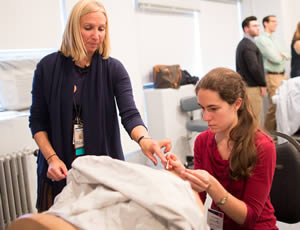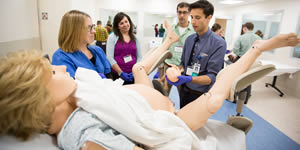

Learning by Doing
Simulation Training for Einstein Medical Students: Practice Makes for Better Care
“Now, try that again,” said Dr. Brian Cohen as a third-year medical student inserted a swab into a speculum lodged in a plastic model of the female pelvic region.
Dr. Cohen, professor of clinical obstetrics & gynecology and women’s health (OB/GYN) at Einstein and an attending physician at Montefiore, was leading a training module for members of the Class of 2017. In a makeshift dress rehearsal at the start of their OB/GYN clerkship rotation, Dr. Cohen was showing the group how to position their instruments to keep the patient comfortable during a pelvic exam.
The practice session—based on a “learn by doing” approach called simulation that is part of a new Einstein educational curriculum—was held in a space appointed to look like an examination room. In reality, the room was located within the Ruth L. Gottesman Clinical Skills Center (CSC), housed in the Van Etten building. Students receive hands-on training in the CSC and in the adjacent Montefiore Einstein Center for Innovation in Simulation (MECIS).
Dr. Marvin Fried, professor and university chair of otorhinolaryngology-head and neck surgery, and Dr. Felise Milan, professor of clinical medicine and director of the clinical skills center, serve as co-directors of MECIS. The center is set up to assist a number of Montefiore Einstein simulation programs for departments including otorhinolaryngology, obstetrics & gynecology and women’s health, emergency medicine, anesthesiology and orthopaedic surgery.
Replicating Reality
Using inanimate models to train workers in high-risk fields to perform their jobs safely and effectively has long been standard practice in the military and in the automotive and airline industries. But it’s relatively new in medicine.
Dr. Staci Pollack, director of undergraduate OB/GYN medical education and associate professor of clinical OB/GYN at Einstein and an attending physician in reproductive endocrinology at Montefiore, created the OB/GYN simulation curriculum in collaboration with Dr. Dena Goffman, associate professor of clinical OB/GYN at Einstein, as well as director of quality, patient safety and simulation for OB/GYN, clinical director of MECIS and attending physician in maternal fetal medicine at Montefiore, and a member of Einstein’s class of 2001.
Thanks to the efforts of Dr. Pollack and her team, Einstein is now making “simu” training an integral part of student education, particularly in OB/GYN. Faculty-supervised mock doctor-patient encounters, featuring lifelike mannequins and plastic models, allow trainees to hone their communication and technical skills in a safe, supportive learning environment.
“Dena’s advice was invaluable, and thanks to support from staff at the MECIS and clinical skills center, as well as involvement of many OB/GYN faculty members, my team and I were able to mobilize the resources needed to provide our students with a simulation program that prepares them for their clinical learning on the wards,” noted Dr. Pollack.
Safety First

Dr. Pollack instructs a student in how to properly insert a speculum and perform a Pap smear.As social change and advances in technology continue to reshape medical practice, various aspects of pregnancy and childbirth are becoming more complex. Assisted Reproductive Technology, high levels of diabetes and obesity, more multiple gestations and cesarean deliveries, older mothers and the ability to treat fetal anomalies in utero all add complexity to caring for patients and present potential risks to patients. Members of the OB/GYN team must be ready to spring into action at the first sign of maternal or fetal distress.
“Medical error is an ongoing cause for concern in obstetrics,” noted Dr. Goffman. “Studies show that adverse events in the labor and delivery room are often associated with poor teamwork and ineffective communication. Research also shows that simulation can be a valuable tool for improving patient safety and quality of care.”
“My predecessor as chair of OB/GYN and Women’s Health, Dr. Irwin Merkatz, recognized the importance of developing an obstetric patient safety program that focused on simulation training,” explained Dr. Sharmila Makhija, professor and current chair of the department. “He provided Dr. Goffman with the initial resources and freedom needed to create the obstetric simulation program, and it has strongly influenced how we’re training the next generation of physicians so that patient safety and quality assurance can be a priority.”
Einstein Montefiore’s first simulation training for attendings, residents and other OB/GYN team members launched in 2010. A year later, a boot camp for interns was initiated, overseen by Dr. Erika Banks, director of graduate education for OB/GYN and professor of clinical OB/GYN, as well as an attending physician in OB/GYN at Montefiore. Professional staff members are now required to attend annual refresher trainings, and “in situ” simulations on the wards also are planned.
The success and positive impact on care-giving and patient outcomes led Dr. Makhija —who also is the Chella and Moise Safra Chair in Obstetrics & Gynecology and Women's Health at Einstein—to establish the department’s quality, patient safety and simulation program, for which she appointed Dr. Goffman as director. “Seeing the broad ways in which simulation can support our goals of providing the best care possible, I felt it was important to expand our mission and focus to include safety and quality-training programs for our physicians, to improve how we deliver care to our patients.”
Montefiore also has teamed with Mt. Sinai, Maimonides, Beth Israel and St. Luke’s/Roosevelt to form a collaborative known as the Hospital Insurance Co. (or HIC), which provides funding for many of the innovative simulators used in the training. The HIC serves as the risk management advisor for its partner hospitals, and is committed to promoting work on safety and quality improvement for all areas of partner hospitals, not just OB/GYN. “Through HIC, we provide training for attending physicians and other health professionals from throughout our partner hospitals,” noted Dr. Goffman.
Getting a Handle via Hands-on Experience

Dr. Goffman supervises students in the delivery of a baby using Noelle, a mannequin simulatorDr. Goffman’s successful trainings for professional staff is what inspired Dr. Pollack to consider integrating simulation training into Einstein’s third-year clerkship. With the help of her colleagues, she launched Einstein Montefiore’s first-ever OB/GYN orientation simulation training for medical students in June 2015. Members of the Class of 2017 were the inaugural users; a second roll-out for the rest of the class followed in the fall.
“The orientation ensures that all students get uniform instruction as well as some actual experience under their belts before they set foot on the wards,” Dr. Pollack explained.
Students spend an afternoon in the simulation lab after some didactic lectures in the morning. In small groups, they visit a series of stations hosted by faculty members who guide them through everything from conducting a breast or pelvic exam to delivering a baby to team communication skills. Other topics include suturing and knot tying; basic laparoscopic skills, and IUD and NuvaRing insertion.
“The hands-on approach was an enjoyable and refreshing change from sitting in a lecture or staring at a computer screen for hours on end,” commented student Adam Nasar.
“Having the simulation experience on day one set a great tone for the rest of the rotation,” added his classmate Aaron Praiss. “It gave us a clear idea about what we’d be doing, what would be expected of us, and how we could improve our skills and technique.”
Delivering Results
“When you’re a student in an actual situation and you’ve never held or operated a particular instrument or device before, you’re going to feel nervous and uncomfortable—and that discomfort becomes a barrier,” observed Mr. Praiss. “With simulation everyone’s baseline goes up a notch, so when you’re on the ward or in the delivery room you’re more likely to say ‘yes’ when you’re invited to participate—and you learn more.”
And this has already borne results, according to Dr. Pollack.
“When we look at how many students have easily gained experience performing required procedures during their OB/GYN clerkship since we instituted the orientation simulations earlier this year, the numbers have clearly gone up. This could reflect greater student comfort or attendings and residents having greater confidence in the students.”
In fact, a randomized study of 30 third-year students performed by members of the department found that students with simulation lab training participated more in actual deliveries during their clerkship rotation than a control group who received only a pre-rotation PowerPoint.
In another study, Dr. Goffman focused on the performance of residents and attending physicians in managing shoulder dystocia (when the baby’s shoulders get stuck behind the mother’s pubic bone). All 71 participants showed significant improvement in their communication skills after simulation training; the residents also improved their technical skills.
Residents, attendings and nurses who apply their skills with real patients after the team training typically give it rave reviews. “They’re much more confident in their ability to manage an obstetrical emergency,” Dr. Goffman noted. “They tell me, ‘It went so much more smoothly. The team knew what to do. We knew what the maneuvers were because we had practiced them.’”
That kind of feedback reinforces what she and her colleagues hope to achieve through providing simulation of various techniques and complex issues.
“Our goal is to prepare clinicians at all levels—including our students—to handle medical emergencies with confidence, consummate skill and seamless collaboration,” she said. “And simulation will help get us there.”
Posted on: Thursday, April 7, 2016

Tablet Blog